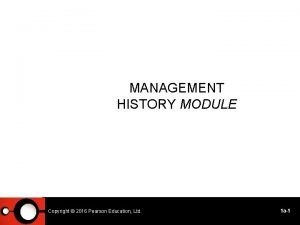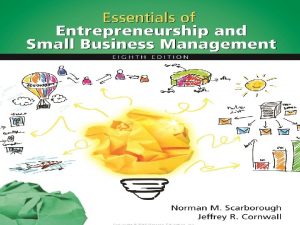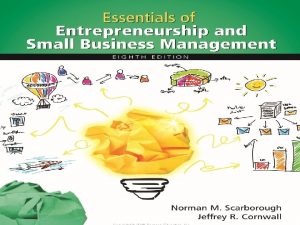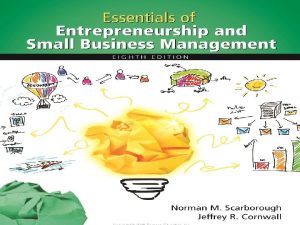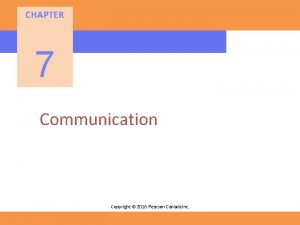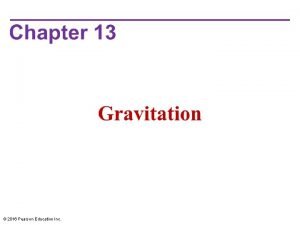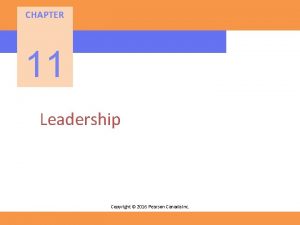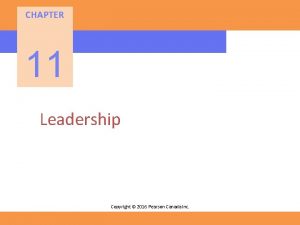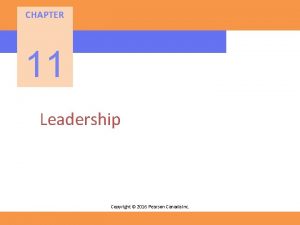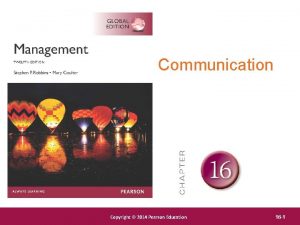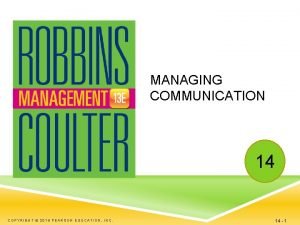CHAPTER 7 Communication Copyright 2016 Pearson Canada Inc
























- Slides: 24

CHAPTER 7 Communication Copyright © 2016 Pearson Canada Inc.

Communication – everywhere & continuous • People spend nearly 70 percent of their waking hours communicating—writing, reading, speaking, listening. • Communication is a foundation for many things that happen among groups and within the workplace – from motivating, to providing information, to controlling behaviour, to expressing emotion. • Good communication skills are very important to your career success. Copyright © 2016 Pearson Canada Inc.

The process of communication Copyright © 2016 Pearson Canada Inc.

Communication Channels • Formal channels – Traditionally follow the authority chain within the organization – Transmit messages related to the professional activities of members • Informal channels – Personal or social messages which are spontaneous and emerge as a response to individual choices Copyright © 2016 Pearson Canada Inc.

Communication Terms Encoding – Converting a message to symbolic form. Decoding – Interpreting a sender’s message. Message – What is communicated. Channel – The medium through which a message travels. Noise – Communication barriers that distort the clarity of the message. Feedback – Checks how successful we have been in transferring our messages as originally intended. – Has an understanding been achieved?

Choosing Channels Channel: The medium through which a message travels, such as a phone call, face-to-face, or text message. Channels differ in their capacity to convey information. Communication apprehension: Undue tension and anxiety about oral communication, written communication, or both. Rich channels have the ability to: Handle multiple cues simultaneously. Facilitate rapid feedback. Be very personal.

Barriers to Effective Communication Filtering The sender manipulates information so that it will be seen more favourably by the receiver. Information Overload Occurs when the information we have to work with exceeds our processing capacity. With emails, phone calls, faxes, meetings, and the need to keep current in one’s field, more employees are suffering from too much information. Silence Defined as an absence of speech or noise. Not necessarily inaction—can convey: Thinking or contemplating a response to a question. Anxiety about speaking. Agreement, dissent, frustration, or anger. Individuals should be aware of what silence might mean in any communication. Silence can be problematic and is common in the workplace. Employees who are silent about important issues may also experience psychological stress. Silence is less likely where minority opinions are treated with respect. Language Words mean different things to different people. Age and context are the two biggest factors that influence such differences Emotions Individuals may interpret the same message differently when you are angry or distraught than when you are happy Depression will most likely hinder effective communication Selective Perception The receivers selectively sees and hears based on their needs, motivations, experience, background, and other personal characteristics. Lying: outright misrepresentation of information. Deliberately withholding information. People are more comfortable lying over the phone than face-to-face. Most people are not very good at detecting deception in others. Copyright © 2016 Pearson Canada Inc.

Nonverbal Communication Includes body movements, facial expressions, and the physical distance between sender and receiver. Two important messages body language conveys: 1) The extent to which an individual likes another and is interested in his or her views and, 2) Relative perceived status between a sender and receiver (i. e. how emotionally close they are to each other) Proxemics The study of physical space in interpersonal relationships.

Organizational Communication – Direction of Communication • Downward – Communication that flows from one level of a group to a lower level. • Managers to employees • Upward – Communication that flows to a higher level of a group. • Employees to manager • Becoming increasingly difficult • Lateral – Communication among members of the same work group, or individuals at the same level. Copyright © 2016 Pearson Canada Inc.

Small- Group Networks • Connections by which information flow. – Formal Networks • Task-related communications that follow the authority chain, and are typically vertical – The Grapevine – Informal Networks • Communications that flow along social and relational lines Copyright © 2016 Pearson Canada Inc.

The Grapevine • 75 percent of employees hear about matters first through rumours (the grapevine). • The grapevine has three main characteristics: – Not controlled by management. – Most employees perceive it as being more believable and reliable than formal communication. – Largely used to serve the self-interests of those people within it. Copyright © 2016 Pearson Canada Inc.

Electronic Communications • Email • Instant Messaging and Text Messaging • Social Networks Copyright © 2016 Pearson Canada Inc.

Instant Messaging (IM) & Text Messaging (TM) • Instant Messaging (IM) – Usually done via computer – Synchronous technology – you have to be there to receive the message and respond • Text Messaging (TM) – Usually done via cell phone – Also synchronous technology, although the text message will be stored (like email) until read Copyright © 2016 Pearson Canada Inc.

Social Media • Nowhere has communication been more transformed than in social networking. • Social media platforms – Facebook – Linked. In – Twitter – Pinterest Copyright © 2016 Pearson Canada Inc.

Blogs • (We)blog – Website about a single person or company that is usually updated daily. • Most blogs are written by individuals, but many organizations and organizational leaders have blogs that speak for the organization • Twitter is a hybrid social networking service for users to post “micro-blog” entries Copyright © 2016 Pearson Canada Inc.

Cultural Barriers to Communication Sources of barriers: – Semantics – Word connotations – Tone differences – Differences in tolerance for conflict and methods for resolving conflicts Copyright © 2016 Pearson Canada Inc.

Cultural Barriers to Communication • Cultural Context: Cultures differ in the importance of the context in influencing the meaning that individuals take from what is actually said or written vs. who the other person is. – High-context cultures • Cultures that rely heavily on nonverbal and subtle situational cues in communication. – Low-context cultures • Cultures that rely heavily on words to convey meaning in communication. Copyright © 2016 Pearson Canada Inc.

Exhibit 7 -5 High- vs. Low-Context Cultures Copyright © 2016 Pearson Canada Inc.

A Cultural Guide • Know yourself • Foster a climate of mutual respect, fairness, and democracy • Learn the cultural context of each person • When in doubt, listen • State facts, not your interpretation • Consider the other person’s viewpoint • Proactively maintain the identity of the group Copyright © 2016 Pearson Canada Inc.

Summary 1. Just because something is said, it does not mean that it was heard. 2. Communication is rarely “objective”. Both the sender’s and receiver’s reality affects the framing and understanding of the message. 3. Information overload is a serious problem for most individuals. Copyright © 2016 Pearson Canada Inc.

OB at Work: For Review 1. 2. 3. 4. 5. 6. What are the key parts of the communication process, and how do you distinguish formal from informal communication? How does channel richness underlie the choice of communication channel? What are some common barriers to effective communication? What are the differences among downward, upward, and lateral communication? What are the differences between formal small-group networks and the grapevine? What potential problems underlie cross-cultural communication? How can they be overcome?

OB at Work: For Managers ■ ■ ■ Remember that your communication mode will partly determine your communication effectiveness. Obtain feedback from your employees to make certain your messages—however they are communicated—are understood. Remember that written communication creates more misunderstandings than oral communication; communicate with employees through inperson meetings when possible. “ Copyright © 2016 Pearson Canada Inc.

OB at Work: For Managers ■ Make sure you use communication strategies appropriate to your audience and the type of message you are sending. ■ Keep in mind that culture can be a communication barrier. Copyright © 2016 Pearson Canada Inc.

Effective Listening If you want to improve your listening skills, look to these behaviours as guides 1. Make eye contact. 2. Exhibit affirmative head nods and appropriate facial expressions. 3. Avoid distracting actions or gestures. 4. Ask questions. 5. Paraphrase. 6. Avoid interrupting the speaker. 7. Don’t over-talk. 8. Make smooth transitions between the roles of speaker and listener. Copyright © 2016 Pearson Canada Inc.
 2016 pearson education inc
2016 pearson education inc 2016 pearson education inc
2016 pearson education inc 2016 pearson education inc
2016 pearson education inc 2016 pearson education inc
2016 pearson education inc 2016 pearson education inc
2016 pearson education inc 2016 pearson education inc
2016 pearson education inc 2016 pearson education inc
2016 pearson education inc 2016 pearson education inc
2016 pearson education inc 2016 pearson education inc
2016 pearson education inc 2016 pearson education inc
2016 pearson education inc 2016 pearson education inc
2016 pearson education inc 2016 pearson education inc
2016 pearson education inc 2016 pearson education inc
2016 pearson education inc 2016 pearson education inc
2016 pearson education inc Pearson education ltd
Pearson education ltd 2017 pearson education inc
2017 pearson education inc Copyright 2010 pearson education inc
Copyright 2010 pearson education inc 2009 pearson education inc
2009 pearson education inc Copyright pearson education inc
Copyright pearson education inc 2014 pearson education inc
2014 pearson education inc Copyright 2010 pearson education inc
Copyright 2010 pearson education inc Copyright 2010 pearson education inc
Copyright 2010 pearson education inc Copyright by pearson education inc. answers
Copyright by pearson education inc. answers 2008 pearson education inc
2008 pearson education inc 2005 pearson prentice hall inc
2005 pearson prentice hall inc


